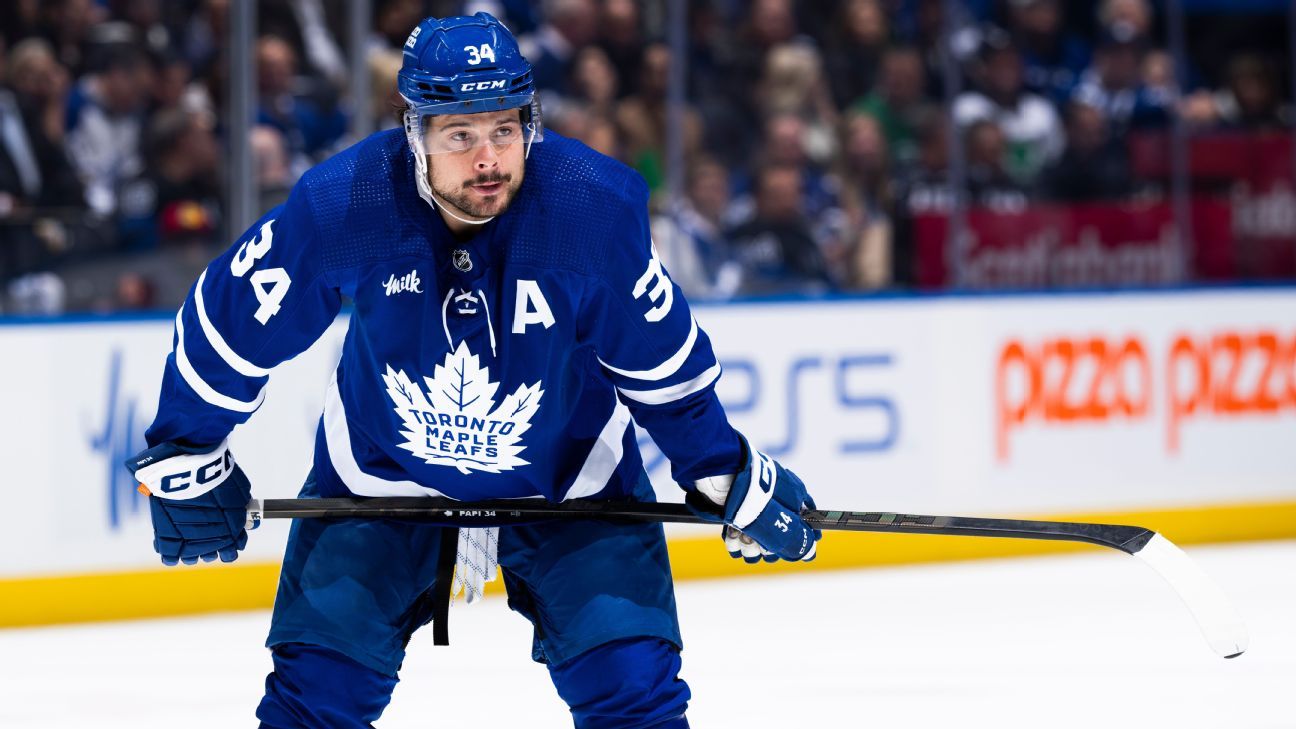-
Rachel Doerrie, ESPNSep 24, 2024, 07:00 AM ET
- Rachel Doerrie is a professional data consultant specializing in data communication and modelling. She’s worked in the NHL and consulted for professional teams across North American and Europe. She hosts the Staff & Graph Podcast and discusses sports from a data-driven perspective.
The NHL preseason is underway, and many teams have new faces. Last season saw some astounding performances, including a 69-goal performance from Auston Matthews, two players (Connor McDavid and Nikita Kucherov) reaching the 100-assist mark, 17 forwards hitting the 40-goal mark and five defensemen scoring at greater than a point-per-game pace. It is hardly bold to say we are unlikely to have a season like that in 2024-25.
Candidates for regression include those most likely to see a 10% drop in production (or more) either in goals or points, based on their situations according to my projections model. The biggest regression factor is shooting percentage; many players featured on this list shot well over their expected paces. While a few may not regress to their career averages, it is likely they will regress toward their talent level and therefore, a dip in goal production would be expected.
Other factors include players expected to be in different situations, team environments or matchups. Most of the players on the list have multiple factors contributing to their projected regression and are certainly not the only players who are likely to experience a meaningful performance regression.
Here are a handful of the most high-profile regression candidates for 2024-25:
Matthews is here for one reason: The probability of scoring nearly 70 goals in any season is extraordinarily low, never mind in back-to-back seasons. Health is always a factor for the league’s premier sniper, as he has reached the 80-game plateau just twice in eight NHL seasons.
Editor’s Picks
2 Related
Matthews shot 2.5 percentage points higher than his career shooting percentage last season, which is not entirely unsustainable. On the other hand, his 51 even-strength goals and setting the record for most hat tricks in a season during the salary cap era (6) were phenomenal.
This season, Matthews is projected for 58 goals, accounting for his games played projection. If Matthews plays a full season, the projection jumps to nearly 64. Matthews needs 53 goals to break Mats Sundin’s franchise goal-scoring record. It is more likely than not that Matthews owns that record by some point this March.
However, it is unreasonable to expect Matthews to score 70 goals this season, making him a candidate for this list because his goal total is likely to decrease by around 15%. It won’t be shocking if Matthews scores more than 60, but 15% regression is the most likely outcome for the new Maple Leafs captain.
Could Reinhart, coming off a shooting percentage nine points higher than his career average, have a Stanley Cup hangover? That’s a regression candidate. Reinhart set career highs in goals (57), power-play goals (27), points (94) and power-play points (34) last season — and not by a slim margin. His previous career high was 33 goals, meaning his goal total jumped 72%.
Finishing with a shooting percentage of 24.5% when his career SH% is 15.6% points to coming regression. Reinhart is projected for 41 goals this season, a nearly 30% drop from his 2023-24 total. On the bright side, a 41-goal season would put Reinhart among the league’s leaders and be the second-highest total of his career.
A major reason for regression outside of shooting percentage is power-play production. Reinhart’s 27 power-play goals were the most in the NHL. While he is expected to remain one of the NHL’s top power-play producers, he is projected for 18 power-play goals, a significant drop-off. Reinhart’s goal total is expected to regress, but his points total is expected to be in the high 80s if he remains healthy.
Reinhart is unlikely to score 57 goals and 94 points, but it’s entirely plausible that he eclipses 40 and 85, which would keep him among the elite two-way players.
A new team with a new system awaits Marchessault in Nashville, after a 42-goal campaign in Vegas. The former Conn Smythe winner shot a career-high 15.8% last season and is projected to finish with 33 goals — a nearly 25% drop. Marchessault will not be the primary power-play shooter in Nashville with Filip Forsberg and Steven Stamkos in the mix. He will see regular top-six minutes, and he is likely to remain a focal point for defenders, especially if he plays with Stamkos.
It is fair to expect regression after he shot 30% better than career average, more so when changing situations and age are taken into account. Marchessault’s 69-point performance last season is projected to fall toward 60 this season.
He will be a key contributor to Nashville’s offense and remain a formidable offensive threat, but the model expects his performance to dip by 15% from last season.
This is a dangerous one, because Hyman is the net front guy on the best power play in decades. He is glued to the hip of the best offensive player of the generation, and he’s going to continue producing while in that situation. Prior to his 54-goal season in 2023-24, Hyman’s career high was 36. Given the situation he plays in, 40-plus goals is a reasonable expectation, with the model projecting Hyman for 42 goals in 2024-25.
Hyman’s shooting percentage was an astounding 18.6%, a major departure from his career percentage of 13.7%. In his seasons as an Oiler, his shooting percentage has been 15%, which is repeatable given his proximity to the net front on his shots and scoring opportunities generated by his line. If Hyman regresses to 15%, he’d need 360 shots to match last season’s goal total. Only three players accomplished that last season (Nathan MacKinnon, Auston Matthews and David Pastrnak). Hyman is likely to score the most goals from the net front in the league this season, but 54 is unlikely to be repeated.
Many factors are at play here, but Kucherov is not expected to tally 144 points again. Neither is Connor McDavid for that matter, but Kucherov is projected to see a 20% dip in production to 115 points. With a 20% decrease in production, he is still expected to finish in the top 5 in league scoring. The model projects him to tally 33 goals and 82 assists.
Play Fantasy Hockey for Free
Create or join a fantasy hockey league on ESPN. Your championship run starts today!
The loss of Stamkos cannot be ignored. The chemistry he had with Kucherov and Victor Hedman on the power play is tough to immediately replicate with another player, regardless of how talented Jake Guentzel is. It is reasonable to expect a period of familiarization and hiccups throughout the season as everyone adjusts to life without the long-time captain.
The Lightning are not as deep as they were during their Stanley Cup years, with major losses to the lineup every season. That’s the price of success in the NHL. It results in a top-heavy lineup where teams will likely key in with their best shutdown players on the Kucherov line.
In past seasons, teams struggled to match up against Tampa Bay because of their depth. This season, Kucherov will get a steady dose of the league’s best defenders, and while he’s capable of winning those matchups, the probability of repeating a 144-point season is less than 15%.
Shiny new contract in hand, Raymond should find himself glued to Dylan Larkin this season. However, it is entirely unreasonable to expect a player to replicate a 19% shooting percentage season when his career mark before last season was 12.6%. Raymond is likely around a 14% shooter and is still developing his NHL scoring toolbox. The model’s projection has his production remaining similar overall, with a reduction in goal scoring and an addition in assists.
This is likely to be the first season where he is a defensive focal point, facing tougher matchups. Playing on the top line with Larkin and Alex DeBrincat should result in elevated scoring opportunities for Raymond, but he is not the primary shooter on that line. He will be relied upon to retrieve pucks, create off the rush and play a two-way role.
To replicate his 31 goals last season at a 14% shooting percentage, Raymond would need to record 222 shots, a 36% increase in shot production and an average of 2.7 per game. His goal production is expected to decrease to the mid-20s, but his assists total is expected to increase to nearly 50. He’s projected for 74 points this season, which is more than respectable for the fourth-year player.
The Canucks had quite the 2023-24 season, winning the Pacific Division title and taking the Oilers to seven games in the second round. The Canucks’ style of play controlled games, and made their team success more sustainable than in past seasons. However, the Canucks had more than a handful of players perform well above their career averages, with many setting career highs. It is unlikely the team regresses in a major way (if Thatcher Demko is healthy by November), but there is reason to believe a few players will not be as productive this season as last.
Top stories of the week from
Get exclusive access to thousands of premium articles a year from top writers.
• NFL: Biggest surprise QB standouts so far »
• Regular-season grades for 30 MLB teams »
• True or false on Premier League trends »
More ESPN+ content »
Brock Boeser hit the 40-goal plateau and was brilliant in the playoffs before being sidelined with a blood clot. All signs point to Boeser being healthy, which is a fantastic bit of news. Boeser shot 19.3% last season, nearly six percentage points higher than his career mark of 13.8%. Given that he’s likely to play with J.T. Miller, he will often be facing opponents’ best shutdown pairing. Furthermore, teams will focus on him defensively and look to limit his scoring opportunities. Brock is projected for a goal total in the low 30s, which would be a solid season for a top-six winger making $6.65 million.
Quinn Hughes‘ point total is likely to regress by about 10% to the mid 80s, but the reigning Norris Trophy winner has established himself as an elite defender in the NHL and that is not expected to change. Hughes will continue to drive play from the blue line and dictate the pace of play for 27 minutes per game. While his offense may dip, his defensive play should remain steady and he’ll continue to be one of the league’s most valuable defensemen.
The Nils Hoglander discourse on Canucks social media over the past few seasons has been quite something. Since his surprise rookie season, the young Canuck has struggled to find his way in a consistent lineup spot. Last season, his shooting percentage skyrocketed to 20%, resulting in 24 goals. When you’re scoring that much, you earn a regular lineup spot; Hoglander played in 80 games. He’s unlikely to match that total this season, but he has proved he can be a contributor at the NHL level. Given the Canucks’ signings of Daniel Sprong and Jake DeBrusk, Hoglander may not have the same opportunities. He is projected to score around 20 goals this season if he remains in a top-six role. Should his role dimmish, that number falls closer to 15.







